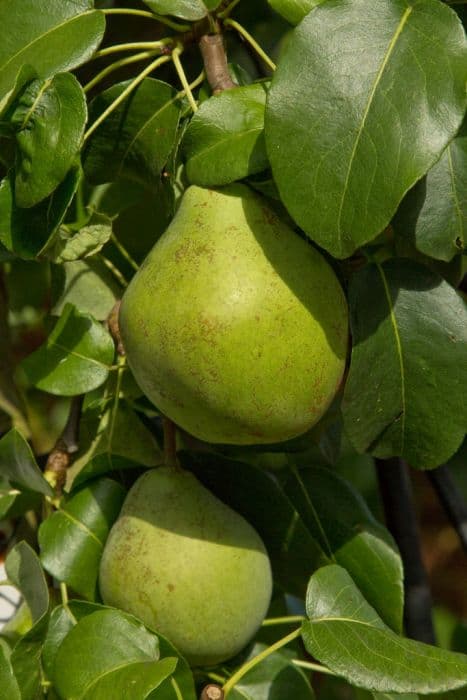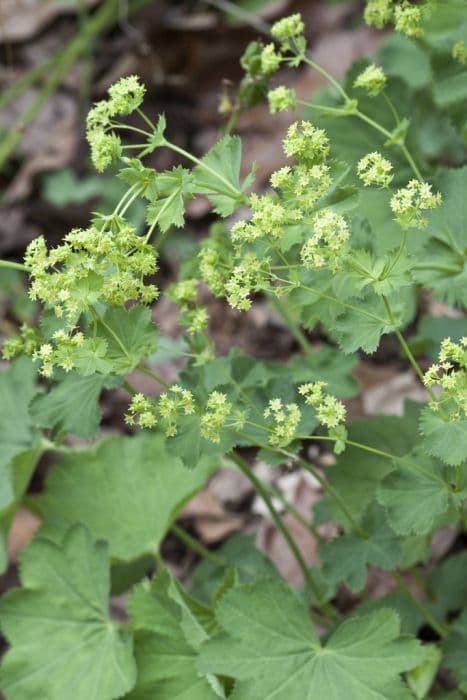Beurre Hardy Pear Pyrus communis 'Glou Morceau' (D)

ABOUT
Pyrus communis 'Glou Morceau', commonly known as the 'Beurré Diel' pear, is a variety of pear tree known for producing dessert pears. This plant displays a typical pear tree appearance with a branching structure that provides a canopy of foliage. Its leaves are broad, with a glossy green color, and a characteristic oval shape with finely serrated edges. As the seasons change, this pear tree blossoms with white flowers that are usually arranged in clusters, providing a visually appealing display in the spring. The flowers are followed by the development of the fruit for which this variety is cultivated - the pears. These pears are known for their plump, bell-like shape that tapers towards the stem. The skin of the 'Beurré Diel' pears is smooth, with a pale green to yellow color that may exhibit a slight blush when exposed to the sun. As the fruit matures, it might show light russeting, which is a brown, netted texture on the surface of the pear. The flesh of the fruit is notably buttery in texture, which is a desirable characteristic among dessert pears, making them juicy and sweet. The pear tree itself conveys a sense of strength and endurance through its woody stems and the rugged texture of the bark, providing an attractive structure year-round, especially when it becomes the backdrop for the soft spring blossoms or the hanging fruit. The overall impression of 'Glou Morceau' is of a lush and productive fruit tree that offers both aesthetic beauty and practical fruit-bearing capabilities.
About this plant
 Names
NamesFamily
Rosaceae
Synonyms
Beurré Diel Pear, Glou Morceau Pear
Common names
Pyrus communis 'Glou Morceau'.
 Toxicity
ToxicityTo humans
The most common common name for Pyrus communis 'Glou Morceau' is European Pear. The European Pear is not toxic to humans. All parts of the pear tree, including the fruit, leaves, and seeds, are generally considered safe for human consumption when prepared properly. However, the seeds contain small amounts of amygdalin, a compound that can release cyanide when digested, but you would need to consume an extremely large quantity of seeds for it to be harmful.
To pets
The most common common name for Pyrus communis 'Glou Morceau' is European Pear. The European Pear is not generally toxic to pets such as dogs and cats. The fruit can be safely eaten by pets in moderation. However, the seeds should be avoided, as they contain amygdalin, which can release cyanide when metabolized. While the amount of cyanide produced by the digestion of the seeds is small, it is still best to keep seeds away from pets to prevent the risk of cyanide poisoning, which can lead to symptoms such as difficulty breathing, panting, and shock. However, such incidents are rare and would typically require the ingestion of a large number of seeds.
 Characteristics
CharacteristicsLife cycle
Perennials
Foliage type
Deciduous
Color of leaves
Green
Flower color
White
Height
16 feet (4.88 meters)
Spread
13 feet (3.96 meters)
Plant type
Tree
Hardiness zones
4-8
Native area
Europe
Benefits
 General Benefits
General Benefits- Ornamental Value: Pyrus communis 'Glou Morceau', commonly known as European Pear, offers aesthetic appeal through its attractive blossoms and foliage.
- Fruit Production: It produces edible fruits that can be consumed fresh, cooked, or canned, adding to homegrown food resources.
- Shade Provider: The tree can offer shade in gardens and landscapes, creating cooler areas during hot weather.
- Wildlife Habitat: Flowers provide nectar and pollen for bees and other pollinating insects, while the fruits can be a food source for birds and mammals.
- Erosion Control: The root system helps stabilize soil and prevent erosion on slopes or in areas prone to the loss of topsoil.
- Seasonal Interest: It exhibits seasonal changes that can add variety to a garden, with spring blossoms, summer foliage, and autumn fruit.
 Medical Properties
Medical Properties- Diuretic Effect: Pear fruit may have mild diuretic properties, which can help promote urination and support kidney health.
- Antioxidant Activity: Pears contain vitamins C and K, and other antioxidants that may reduce oxidative stress and support overall health.
- Digestive Health: The fiber in pears can contribute to maintaining a healthy digestive system by promoting regularity.
- Soothing Agent: Pear juice is sometimes recommended for its soothing properties and may be gentle on the stomach.
 Air-purifying Qualities
Air-purifying QualitiesThis plant is not specifically known for air purifying qualities.
 Other Uses
Other Uses- Pear wood is often used in high-quality woodwind instruments due to its fine grain and dense structure, providing excellent sound quality.
- Pear trees can be trained into decorative forms for aesthetic purposes in gardens, such as espaliers or cordon shapes.
- Pear leaves can be used as a natural fabric dye, yielding a range of yellow to green hues on fibers.
- The wood of the pear tree can be used in fine furniture making due to its hardness and attractive grain patterns.
- Pear blossom flowers are sometimes used for ornamental decoration in floristry and can be crystallized for cake decorations.
- The fruit can be used in making wine or perry, an alcoholic beverage similar to cider, made from fermented pears.
- Wood from pear trees is valued by woodcarvers for its fine texture, making it suitable for detailed carving projects.
- Pear wood can be used to make high-quality kitchen utensils, such as cutting boards and spoons, as it is dense and has a closed grain that resists absorption.
- Dried pear wood chips can be used for smoking meats, imparting a sweet and fruity flavor to the smoked products.
- The rough bark of older pear trees can be used in landscaping as a textured mulch that provides ground cover and reduces weed growth.
Interesting Facts
 Feng Shui
Feng ShuiPear tree is not used in Feng Shui practice.
 Zodiac Sign Compitability
Zodiac Sign CompitabilityPear tree is not used in astrology practice.
 Plant Symbolism
Plant Symbolism- Longevity - Pyrus communis, commonly known as the pear tree, often represents longevity due to its capacity to live and bear fruit for many years.
- Hope - The pear blossom is a symbol of hope, as it is one of the first flowers to bloom in the spring, signaling the end of winter.
- Love - In many cultures, the pear tree is a symbol of love and affection, perhaps due to the sweet fruit it bears or because it grows and prospers for many generations.
- Prosperity - Pears can represent prosperity and abundance as the tree generously produces fruit each year.
- Health - The nutritious nature of pears leads to their representation as a symbol of physical health and well-being.
 Water
WaterEuropean Pear trees, such as 'Glou Morceau', require deep watering to establish an extensive root system. Water the trees with about 1 to 2 gallons once a week during their first growing season. In subsequent years, they'll need a deep watering every two weeks unless there's significant rainfall. During the hot summer months or in very dry conditions, increase watering to once per week. Avoid shallow watering, as it can lead to weak root development and health issues for your tree.
 Light
LightEuropean Pears, including 'Glou Morceau', thrive best in full sun conditions. They should be placed in a location where they receive at least six to eight hours of direct sunlight daily. A spot with southern or western exposure is typically ideal to ensure your pear tree gets ample sun to produce healthy fruits and strong growth.
 Temperature
TemperatureThe European Pear 'Glou Morceau' prefers a temperate climate and can withstand winter cold to about -20°F, while summer heat should ideally not exceed 90°F. The ideal growing temperatures for a European Pear tree are between 35°F and 85°F, ensuring sufficient dormancy in winter and adequate warmth for fruit set in the spring and summer.
 Pruning
PruningPruning European Pear trees, including 'Glou Morceau', helps maintain tree health, encourage fruit production, and improve air circulation. Prune in late winter when the tree is dormant, removing dead or diseased wood, thinning out crowded branches, and shaping the tree. Annual pruning is typically sufficient, but monitor the tree's growth and condition throughout the year for any necessary additional trimming.
 Cleaning
CleaningAs needed
 Soil
SoilThe European pear 'Glou Morceau' prefers well-draining loamy soil enriched with organic matter; a soil pH of 6.0 to 7.5 is ideal. Mix garden soil with compost and sand for best results.
 Repotting
RepottingEuropean pear 'Glou Morceau' trees, when grown in containers, should be repotted every 3 to 5 years to refresh the soil and provide room for growth.
 Humidity & Misting
Humidity & MistingEuropean pear 'Glou Morceau' tolerates a wide range of humidity levels but thrives best in average outdoor humidity.
 Suitable locations
Suitable locationsIndoor
Provide bright light, cool temps, and space for growth.
Outdoor
Plant in full sun, well-draining soil, protect from wind.
Hardiness zone
4-8 USDA
 Life cycle
Life cyclePyrus communis 'Glou Morceau', commonly known as the European Pear, begins its life as a seed, which under suitable conditions germinates in soil to produce a small seedling. This seedling grows through vegetative stage into a young tree, developing a strong root system and a woody stem. As it reaches maturity, the European Pear tree enters a flowering stage annually in the spring where it produces white flowers that are important for pollination by insects. Following pollination, the tree sets fruit, which grows and ripens typically in late summer to fall. After the fruit has been harvested or falls naturally, the tree enters a dormancy period during the colder months, conserving its energy. The cycle repeats as the tree awakens in the next spring, with the potential lifespan of a European Pear tree being several decades if conditions are optimal.
 Propogation
PropogationPropogation time
Autumn
Pyrus communis 'Glou Morceau', commonly known as the European Pear, is often propagated by grafting, which is considered the most popular method for this variety. This can be carried out in late winter to early spring before the sap begins to actively rise. A piece of a desired pear tree variety, known as the scion, is grafted onto a rootstock, which is chosen for its adaptability to soil and disease resistance. The scion should be about 6 to 8 inches (15 to 20 centimeters) long, with two to three buds. It is joined to the rootstock by making clean cuts on both the scion and the rootstock ensuring they fit together snugly and securing them with grafting tape or compound. This union will allow the scion to receive water and nutrients from the rootstock, eventually growing into a productive pear tree of the 'Glou Morceau' variety.









